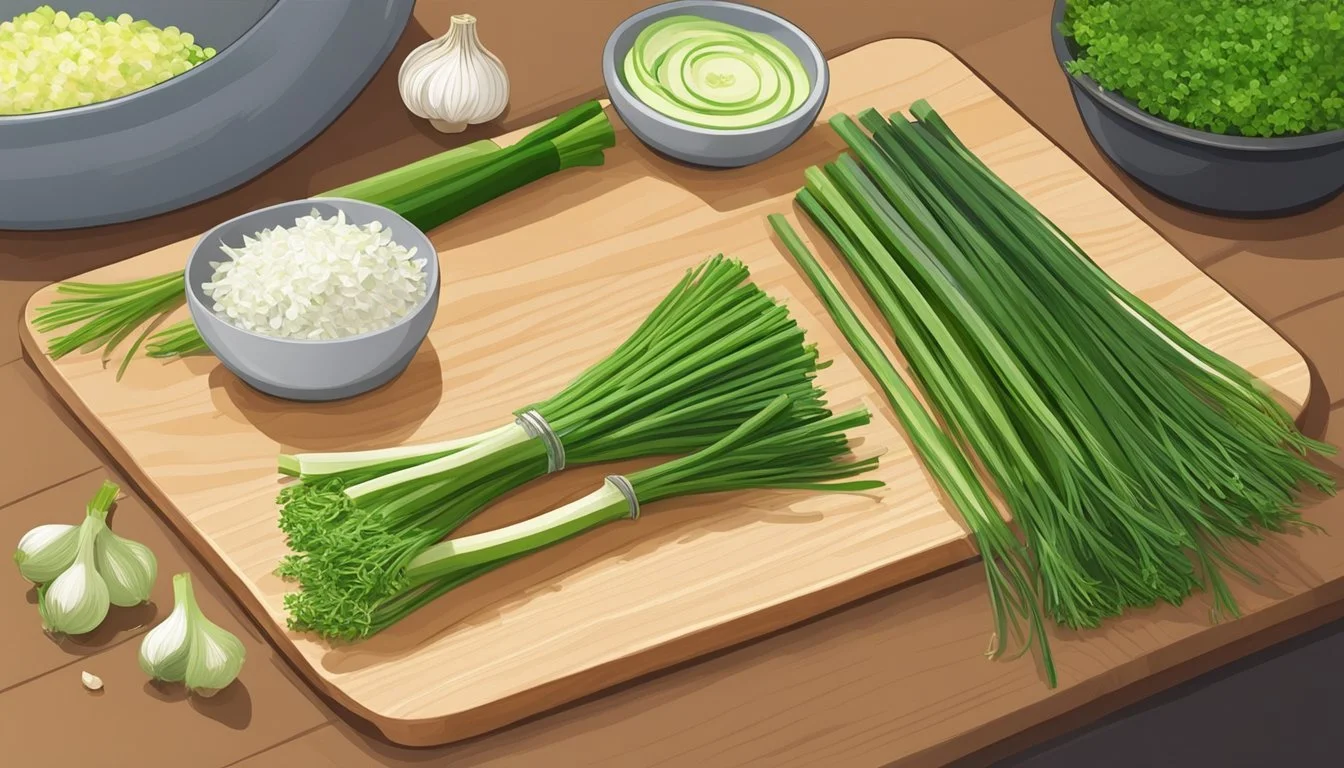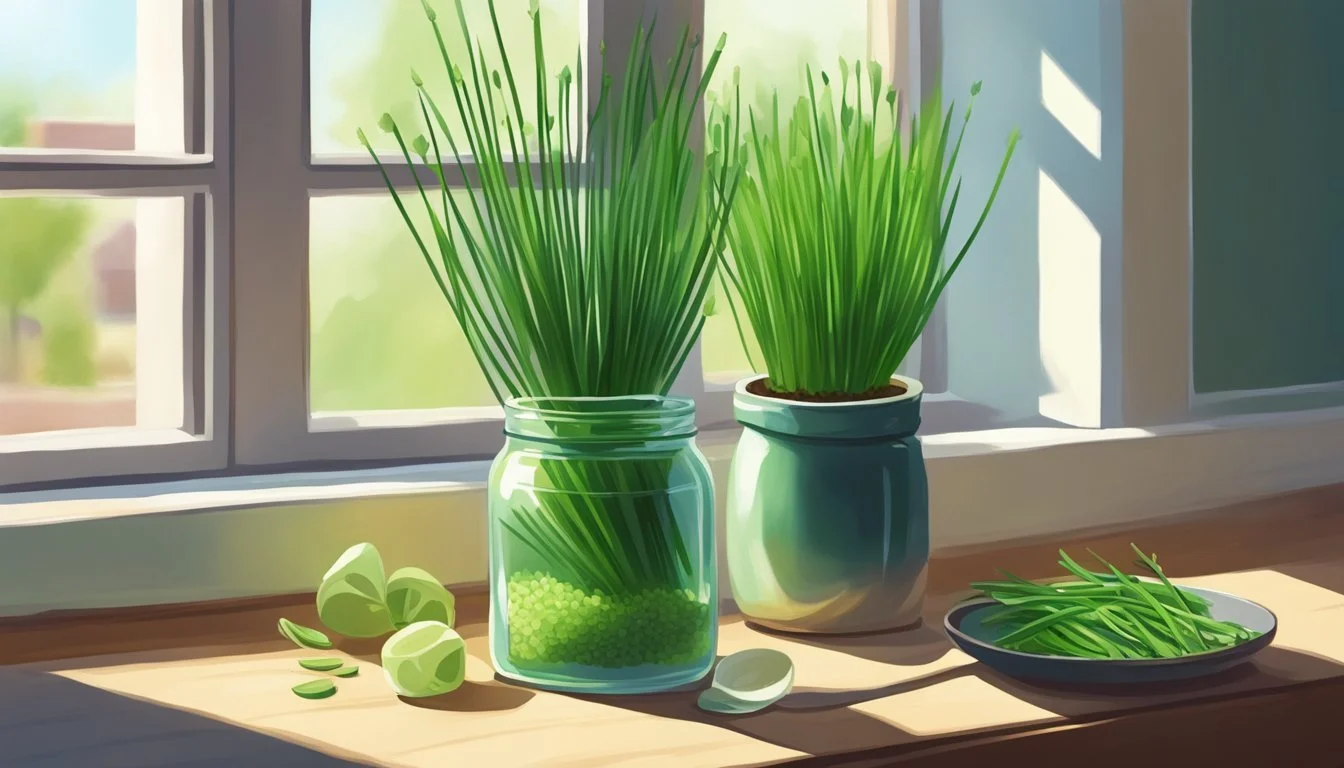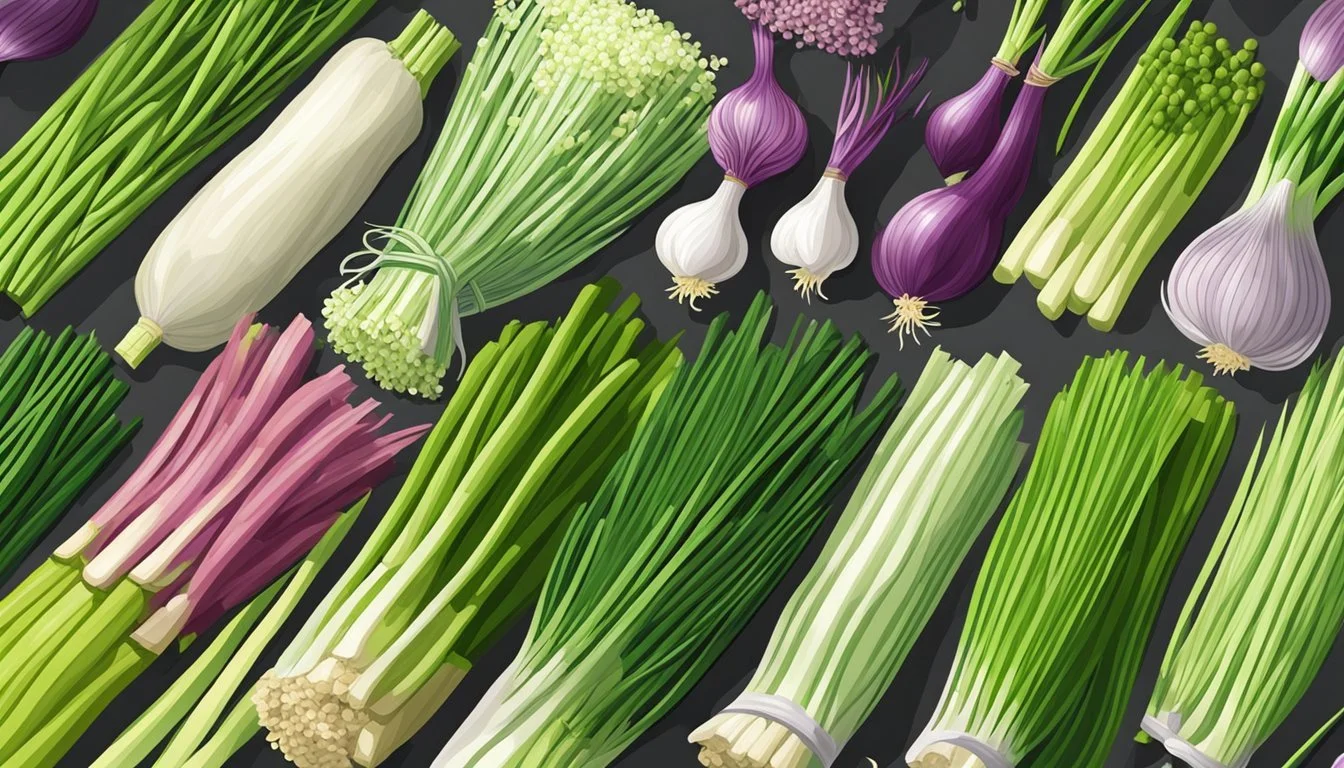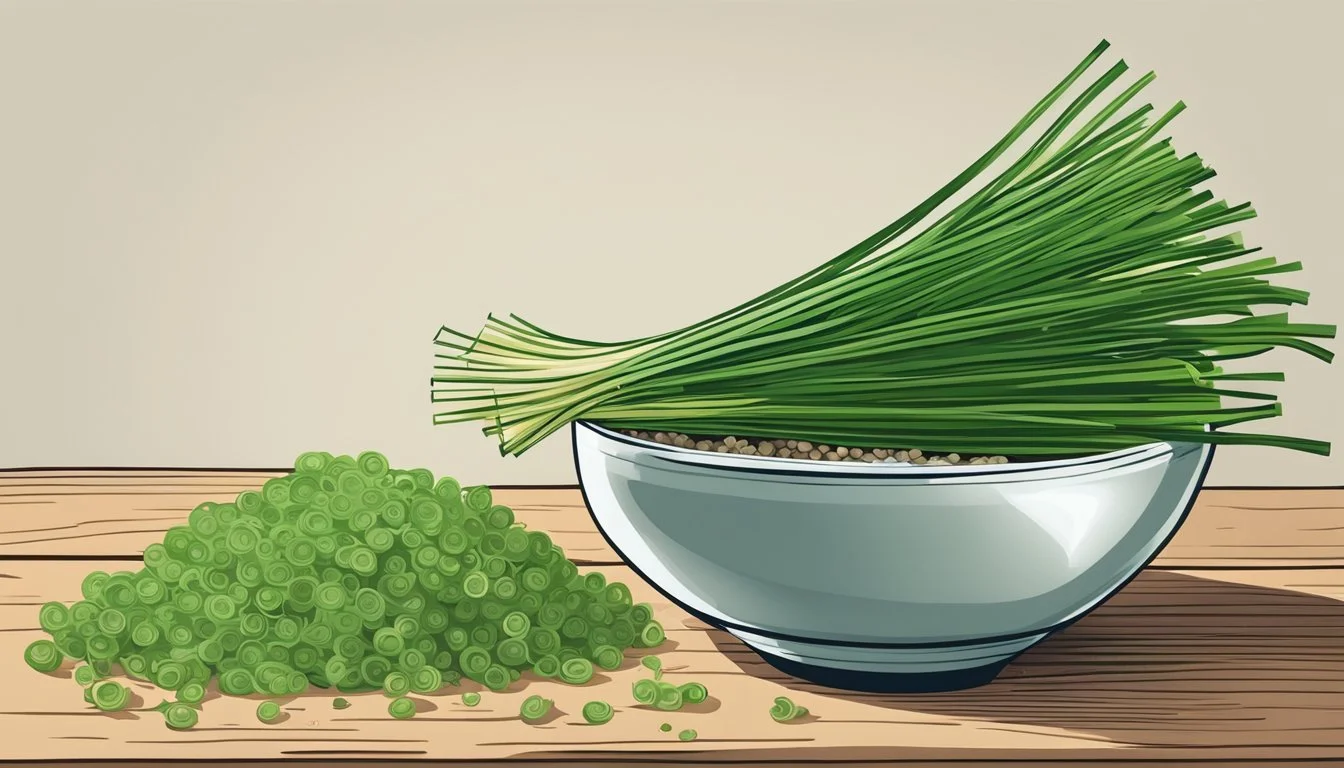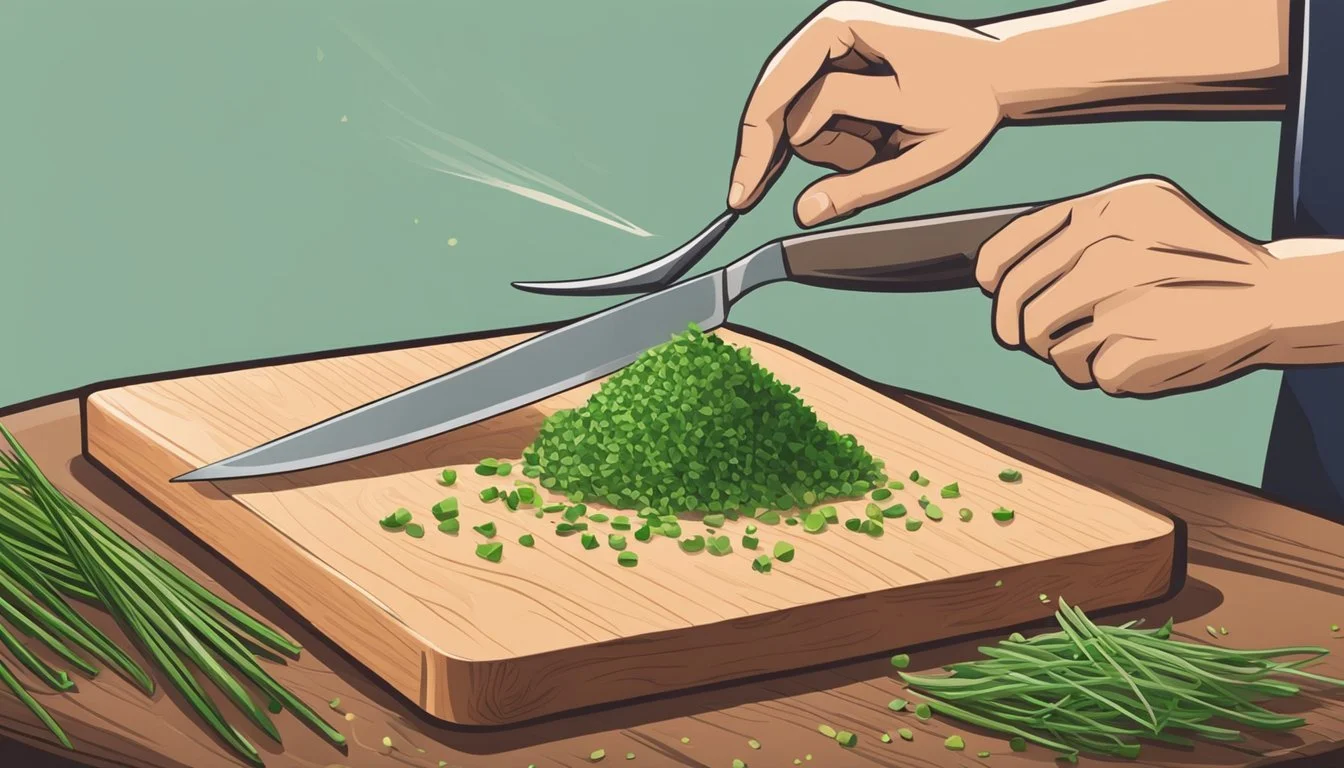Chives Substitutes
Top Alternatives for Your Recipes
Chives, with their delicate onion flavor and bright green color, are a popular herb used in a variety of culinary dishes. However, when chives are not available or someone is looking for a variation in taste or texture, there are several suitable substitutes that can be used to achieve a similar effect in cooking. Finding the right chive alternative can depend on the specific flavors in the dish and the textural components the recipe requires.
Green onions or scallions are often the go-to substitute for chives due to their close flavor profile and appearance. They are part of the same allium family and provide a slightly stronger onion taste, which can enhance the depth of flavor in a dish. Other relatives of chives such as leeks, garlic scapes, and ramps also serve as excellent alternatives, offering variations in intensity and pungency to suit different palates and recipes. Beyond the allium family, certain fresh herbs like parsley, dill, and tarragon can stand in for chives, contributing unique flavors that complement the original intention of the dish.
Understanding Chives
Chives belong to the Allium genus, making them a proud member of the extensive onion family, which includes garlic, scallions, and leeks. As a perennial plant, chives are not only a reliable herb in the kitchen garden but also an attractive border plant due to their lush, green appearance and purple flowers.
In the culinary world, chefs and home cooks treasure chives for their subtle onion-like flavor which can be described as both mild and slightly garlicky. The herb's leaves are the primary part used in cooking, often snipped finely to become an aromatic garnish.
Uses in Cooking:
Garnish: Fresh snips direct onto dishes
Flavoring: Incorporated into soups, dips, and potato dishes
Traditionally, chives serve two primary roles in the culinary arena:
Flavor: They add a delicate zing to dishes without overpowering other ingredients.
Garnish: Their bright green color provides a fresh visual appeal to meals ranging from baked potatoes to elegant canapés.
Nutritional Profile: Chives are also noted for their nutritional benefits, containing small amounts of vitamins A and C, along with essential minerals.
With their gentle flavor, chives enhance a wide array of dishes, establishing their status as an indispensable herb in kitchens worldwide.
Common Chives Substitutes
When a recipe calls for chives and they are not available, one can find suitable alternatives that provide a similar flavor profile and aesthetic. Both fresh and dried herbs can be employed as substitutes, with variations that cater to the recipe's specific needs.
Fresh Herbs as Substitutes
Scallions/Green Onions: The closest in flavor and appearance, they can be used in equal amounts.
Leeks: With a milder taste, they are best used in cooked dishes.
Parsley: Offers a fresh taste and vibrant color, suitable for garnishing.
Tarragon: An anise-like flavor that complements chicken and fish dishes well.
Basil: Sweet and fragrant, ideal for Mediterranean cuisine.
Dill: Delicate and slightly tangy, fitting for dips and seafood.
Mint: Adds a fresh and zesty note to salads and Middle Eastern dishes.
When using fresh herbs, one should always consider the specific flavors of the herb and how it pairs with other ingredients in the recipe.
Dried Herbs as Alternatives
Dried Chives: They retain much of the mild onion flavor and work well when fresh chives are unavailable.
Dried Parsley: Less vibrant but can still add a hint of color and flavor.
Dried Tarragon: More concentrated in flavor, use sparingly to avoid overpowering.
Dried Basil: Works well in sauces and dressings where fresh basil is called for.
Dried Dill: A stronger flavor than fresh, excellent in dips and spreads.
Dried Oregano: Offers a robust flavor suitable for Italian and Mexican dishes.
Dried Mint: Perfect for infusing dishes with a subtle minty essence.
Dried herbs are generally more potent than their fresh counterparts, so they should be used in smaller quantities, typically as a third of the amount one would use if fresh.
Onion Family Variants
When looking for substitutes for chives, several members of the onion family offer a range of flavors and textures suitable for different culinary applications.
Green Onions and Scallions
Green onions and scallions serve as the closest substitutes for chives, providing a mild onion flavor with a crisp texture. They can be used interchangeably in recipes that call for chives, yet they tend to have a slightly more pronounced taste.
Leeks and Garlic Chives
Leeks have a delicate, sweet onion flavor that makes them a good alternative to chives, especially in cooked dishes. Only the white and light green parts should be used.
Garlic chives, also known as Chinese chives, bring a subtle garlicky taste to dishes, differentiating them from common chives which lack the garlicky note.
Shallots and Onion Types
Shallots offer a subtle hint of garlic and a mild onion flavor that can complement dishes similarly to chives. They work particularly well in vinaigrettes and sauces.
Traditional onion types such as yellow, white, and red onions can be too overpowering as a chive substitute but can still be used in lesser quantities to achieve a desired flavor profile.
Non-Traditional Substitutes
When the traditional stand-ins for chives are unavailable, one can explore a variety of non-traditional substitutes that bring unique flavors and textures to dishes. The following sections outline some vegetable alternatives and unconventional herbs and spices that can serve as chive substitutes in a pinch.
Vegetable Alternatives
Leeks: These are part of the allium family, much like chives, and provide a gentle onion flavor that can complement many dishes. The white and light green parts are particularly suited for substituting chives when cooked.
Celery: With its crisp texture and subtly peppery taste, celery can be a surprising chive stand-in, especially in raw applications such as salads and as garnishes.
Garlic Scapes: The milder cousin of garlic, garlic scapes offer a delicate garlicky flavor that works well in place of chives without overwhelming other ingredients.
Ramps: Also known as wild leeks, ramps have a strong onion-garlic flavor that can be quite potent, so it is suggested to use them sparingly as a chive substitute.
Unconventional Herbs and Spices
Thyme: While thyme differs significantly in taste from chives, its earthy and slightly floral notes can bring a new dimension to recipes that traditionally rely on chives for an aromatic touch.
Rosemary: Recognizable by its needle-like leaves, rosemary imparts a robust, pine-like taste. Due to its intensity, rosemary should be used in smaller quantities compared to chives.
These alternatives may not perfectly mimic the mild, oniony taste of chives, but they can infuse your culinary creations with their unique profiles, making your dishes stand out in both flavor and presentation.
Considerations for Cooking and Garnishing
When selecting substitutes for chives in cooking and garnishing, chefs should consider the intended use in the recipe. For garnishing, substitutes need to have an appealing appearance along with a flavor complement that does not overpower the dish. In contrast, cooking with chive substitutes allows for more flexibility as the flavors meld within the dish, and visual appeal is less critical.
For garnishing purposes:
Scallions provide a similar green color and a fresh look.
Finely chopped parsley can offer a bright appearance, though the taste differs.
In sauces and dressings:
Green onions, with their mild flavor, can successfully replace chives.
Garlic scapes bring a subtle garlicky flavor suitable for such liquid accompaniments.
Regarding salads, cooked dishes, and omelets:
Subtle-tasting herbs like leeks (using only the white and light green parts) mesh well without dominating the flavor profile.
Shallots can enhance the dish with their mild, yet slightly more robust, taste.
For heartier meals like soups and stews:
Consider leeks or the white parts of green onions, as they soften well and infuse the broth with a mild onion essence.
In mashed potatoes:
Garlic scapes chopped finely, or dried minced onion can complement the creamy texture with a burst of flavor.
When chives are not available, these alternatives can fill the gap while respecting the integrity of the original dish. It's important to experiment with quantities to ensure a balanced outcome, tailoring each substitution to the specific needs of the recipe in question.
Ratios and Measurements
When substituting chives in recipes, it is important to account for differences in flavor intensity, size, and water content. The proper ratios and measurements will ensure that the dish maintains a balanced flavor profile.
Green Onions (Scallions): Scallions have a slightly stronger onion flavor compared to chives. An appropriate substitution ratio would be to use green onions in a slightly reduced amount.
Ratio: For 1 tablespoon of finely chopped fresh chives, substitute with 1 tablespoon of finely chopped green onions.
Dried Chives: When fresh chives are unavailable, dried chives can be a convenient alternative. However, dried chives have less water content and a more concentrated flavor.
Ratio: For 1 tablespoon of fresh chives, substitute with 1 teaspoon of dried chives.
Leeks: The milder part of leeks (the white and light green sections) can be used as a substitute for chives. Since leeks are larger in size, they should be finely chopped to resemble the texture of chives.
Ratio: Use leeks in the same quantity as chives, finely chopping only the tender parts of the leek.
Dill: Dill can replace chives to provide a unique flavor profile, featuring a blend of anise and parsley. While dill is more potent, chefs should adjust measurements accordingly.
Ratio: Due to its stronger taste, use a lesser amount of dill, approximately half of the quantity of chives called for in the recipe.
By adhering to these ratios and measurements, cooks can effectively substitute chives with alternative ingredients while maintaining the integrity of the original dish's flavor.
Preservation Methods
Preserving chives effectively extends their usability beyond the fresh harvest season, allowing users to retain the herb's essence in various forms suited for later culinary use.
Using Dried Chives
Drying chives is a straightforward method for preservation. Individuals can air-dry chives by hanging bunches upside down in a well-ventilated, dry area away from direct sunlight. It typically takes several days for the chives to dry completely. Once dried, the chives should be crumbled and stored in an airtight container, away from light and heat to maintain their natural flavor and color. Drying reduces fresh chives to a more concentrated form, making dried chives a potent substitute in recipes requiring the herb's distinctive yet delicate onion-like flavor.
Freezing and Storing Fresh Herbs
For retaining a flavor that's closer to fresh, chives can be frozen. The process involves thoroughly washing and patting them dry before finely chopping. One can then place the chopped chives in ice cube trays, covering them with water or olive oil before freezing. Another approach is to lay the chives flat in a single layer on a baking sheet to freeze before transferring them to a sealed bag or container. Freezing chives preserves their natural flavor and color, making them an ideal addition to dishes when fresh herbs are not available. Frozen chives can be used directly from the freezer and don't require thawing.
Health and Nutrition Aspects
When considering substitutes for chives in a recipe, the nutritional impact of the alternatives is worth examining. Chives themselves are low in calories and provide a burst of flavor without adding substantial fat or sodium to dishes. In contrast, some alternatives may offer different health benefits.
Scallions are closely related to chives and have a similar nutrient profile, being low in calories with a subtle, less pungent flavor than chives. Both greens contain vitamin K, necessary for blood clotting and bone health.
Leeks, another relative in the allium family, share similar nutritional properties but are typically used in larger amounts due to their larger size. When cooked, leeks offer a milder flavor compared to the more garlicky notes of chives.
For a distinctively different flavor, garlic and garlic scapes can be used. They provide a more robust and pungent garlic flavor and contain allicin, a compound that may have beneficial effects on heart health and immunity. However, due to their stronger taste, chefs should use them sparingly to avoid overpowering the dish.
Substitute Flavor Profile Caloric Content Scallions Mild, slightly sweet Low Leeks Mild when cooked Low Garlic Scapes Strong, pungent garlic flavor Low
Substituting chives with any of these alternatives can contribute varying flavors as well as different nutritional benefits. It's important to match the substitute's flavor intensity and caloric contribution to the requirements of the recipe and nutritional goals.
Culinary Applications
The versatility of chives in the kitchen is notable, as they embellish a wide array of dishes with their delicate onion flavor and vibrant green touch. When chives aren't available, numerous substitutes can seamlessly fit into recipes, complementing both the taste profile and appearance.
Recipes Featuring Chives Substitutes
Scallions, often suggested as the closest alternative to chives, stand out in their ability to adapt to various recipes. They can be finely chopped and sprinkled over mashed potatoes for a slight bite. Another excellent chive stand-in is Chinese leek (garlic chives), which brings a more pronounced flavor, fitting perfectly within stir-fries and savory pancake recipes.
Dips and spreads that typically rely on chives for a mild onion hint can benefit from incorporating shallots; their subtle sharpness makes them suitable for such applications. In Mediterranean cooking, fennel fronds are lauded for their delicate licorice essence, which complements fish and chicken dishes while doubling as an appealing garnish.
For dishes requiring a cooked component, like savory pies or quiches, (What wine goes well with quiche?) finer options such as leeks blend well, contributing a mild yet present flavor.
Table of Chives Substitutes in Recipes:
Substitute Best Used In Notes Scallions Salads, Garnishes A direct swap for chives Chinese Leek Asian Dishes, Savory Pancakes Stronger, more garlicky flavor Shallots Dips, Spreads Adds a sweet yet sharp taste Fennel Fronds Fish, Chicken Dishes Anise-like sweetness Leeks Soups, Pies, Quiches Milder taste, good for cooking
Incorporation in Different Cuisine Types
Chive substitutes find their way into diverse cuisines around the world. Scallions serve as a staple in Asian cooking, frequently paired with ginger, garlic, and soy sauce to create a savory and slightly pungent flavor profile in dishes like dumplings and noodle bowls.
In European cuisine, particularly within the Mediterranean region, leeks and fennel fronds are common counterparts. Leeks offer a subtle onion flavor to potato and vegetable dishes, while fennel fronds can impart a sweet licorice-like taste that's well-suited to salads and seafood.
For classic comfort foods such as mashed potatoes, savory dips, or sandwiches, less pungent alternatives like parsley can be used. They don't overpower the palate and provide a fresh, herbaceous note.
The art of substituting chives is understanding the flavor balance of the dish at hand. It's crucial to consider the intensity of the substitute and how it harmonizes with the other ingredients to achieve the desired savory, sweet, or sour notes.
Gardening Tips for Chives
Chives, a member of the allium family, are a popular choice for gardeners seeking to grow their fresh herbs. They require certain conditions to thrive, and understanding these will ensure a healthy growth cycle.
Location: Chives flourish in areas that receive full sun, meaning at least 6 hours of direct sunlight per day. It is essential to choose a spot in the garden where they can soak up plenty of light.
Soil Requirements: A well-drained soil is ideal for chives. They prefer a slightly acidic to neutral pH. Before planting, enrich the soil with organic matter to promote healthy growth.
Planting:
Sow seeds ¼ inch deep in the soil.
Space the plants 4 to 6 inches apart to allow ample room for growth.
Watering: Chives do not require excessive watering. It's important to ensure the soil is moist but not waterlogged. Over-watering can lead to root rot.
Fertilizing: While not heavy feeders, a balanced fertilizer can be applied in spring to help nourish the plant.
Harvesting Tips:
Wait until the plants are at least 6 inches tall before harvesting.
Cut only one-third of the leaves at a time to let the plants recover and regrow.
Pest Control: Chives are relatively resistant to pests, but an occasional check for aphids and thrips is a good preventative measure.
By adhering to these gardening practices, chives can be a delightful addition to one's collection of fresh herbs, offering not just culinary benefits but also aesthetic appeal with their delicate purple flowers.
DIY: Growing Substitutes
When seeking alternatives for chives in your cooking, consider growing your own substitutes. These can be cultivated either indoors for convenience or outdoors to take advantage of natural conditions.
Indoor Herb Gardening
For those with limited outdoor space, starting an indoor herb garden is a viable alternative for growing chive substitutes. By controlling the environment, one ensures a year-round supply of herbs. Especially for substitutes like scallions or wild garlic, indoor pots placed in a well-lit area can yield a continual harvest. Ensure the pots have good drainage and use soil rich in organic matter. Position them in a spot that receives at least 6 hours of sunlight, or supplement with grow lights.
Scallions:
Sunlight needs: Bright, indirect light.
Watering: Keep the soil moist but not soggy.
Wild Garlic:
Sunlight needs: Full to partial sunlight.
Watering: Let the soil dry a bit between watering.
Outdoor Cultivation for Alternatives
Garden enthusiasts may opt for outdoor cultivation to grow chive substitutes. Making use of full sun exposure, plants like Chinese leeks and other robust flavored herbs can thrive. One needs to prep the garden soil by mixing in compost to enrich its fertility and to ensure proper water drainage.
Chinese Leeks:
Sunlight needs: Full sun for optimal growth.
Soil: Well-drained, fertile soil with a pH between 6.0 and 7.0.
Wild Garlic:
Often found naturally in woodlands, these could also be cultivated in a shaded section of the garden if one seeks a milder flavor intensity similar to chives.
Both indoor and outdoor methods of cultivating chive substitutes not only enhance dishes with fresh flavors but also contribute to sustainable living practices by reducing the need for store-bought herbs.
Flavor Profiles and Pairings
When selecting substitutes for chives in a recipe, understanding the flavor profiles and how they pair with other ingredients is crucial. Chives are known for their delicate flavor, which is mildly sweet and subtly peppery, without the pungent kick of larger onions. They also add a fresh color and crunchy texture that can enhance the presentation and sensory experience of a dish.
Scallions, or green onions, are the closest match to chives. Their flavor is similar but slightly more intense. They are excellent when one desires a mild onion taste with a bit more bite. Pair scallions with potatoes, eggs, or in salads for an aesthetic and flavorful similarity to chives.
Leeks, particularly the white and light green parts, offer a softer flavor when cooked. Their delicate sweet taste is fitting for soups, omelets, and pasta dishes, making them a suitable replacement when a gentler onion flavor is needed.
Substitute Flavor Profile Best Used In Scallions Strong oniony, bright Baked potatoes, soups, salad Leeks Mildly sweet, subtle Omelets, pasta, soups
Consider the texture of the substitutes as well. Chives provide a certain crunch that may not be replicated by all alternatives, especially if they are cooked.
For fresh garnishing, parsley is vibrant in color and offers a crisp texture. While not onion-flavored, it can mimic the visual appeal of chives. Other herbs may have bolder flavors but can be used sparingly when a more pronounced taste is desired alongside other complementary herbs.

